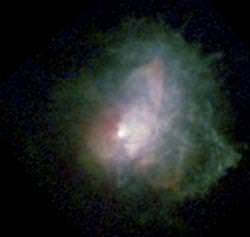 VY Canis Majoris, located about 5,000 light-years away, is no ordinary star; it’s a supergiant, containing 30 to 40 times the mass of our own Sun. And it’s so luminous it’s also considered a hypergiant, shining 500,000 times as bright as the Sun. And it’s big… really big. If this star lived in our Solar System, its surface would extend out to the orbit of Saturn.
VY Canis Majoris, located about 5,000 light-years away, is no ordinary star; it’s a supergiant, containing 30 to 40 times the mass of our own Sun. And it’s so luminous it’s also considered a hypergiant, shining 500,000 times as bright as the Sun. And it’s big… really big. If this star lived in our Solar System, its surface would extend out to the orbit of Saturn.
Unfortunately, VY Canis Majoris is about to die. New images from the Hubble Space Telescope and the W.M. Keck Observatory show how vast eruptions on its surface have formed loops, arcs and knots of material spraying out into space.
Astronomers originally believed that supergiants lost their material in a simple and spherical way, but these images show that the process is anything but clean and tidy. Each loop and arc surrounding the star can be traced back to tremendous outbursts that occurred over the last 1,000 years. VY Canis Majoris is normally losing material all the time, but during these outbursts, the star loses 10 times as much mass as its regular rate.
The outbursts probably originated from massive spots on the star’s surface, similar to the magnetic field, flares and coronal mass ejections from the Sun, but on a vastly larger scale. VY Canis Majoris has enough of magnetic field to generate these massive outflows.
Original Source: Hubble News Release

And just think, canis majoris is only one of the little tiny stars G-D spoke forth into existence out of His mouth. Imagine how large He has to be … and in comparison, how very small we are, little specks, invisible in comparison to canis majoris — heck, the whole earth is invisible compared to canis majoris, and we can’t even locate ourself on the earth from a satellite photo of our home town! And He created us, too. Amazing!